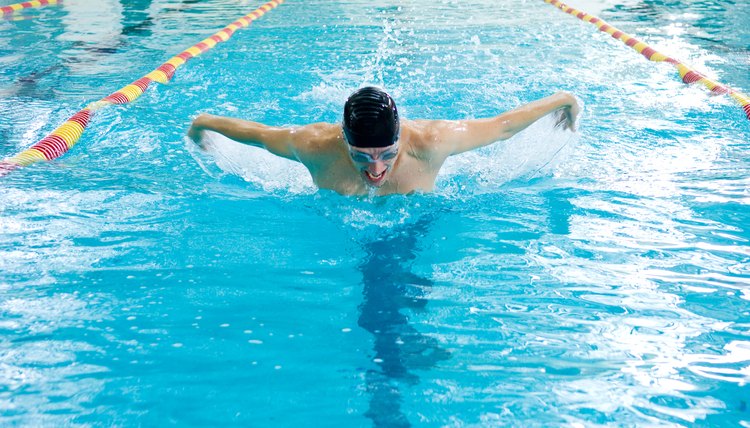How Do Swimming Touch Pads Work?

A swimming touch pad is an automatic electronic timing device used in swimming competitions. It accurately records an athlete’s time and eliminates human error. An "Athletic Business" article quotes Mick Nelson, Club Facilities Development Director for USA Swimming, as saying that with the use of touch pads “we're not at the mercy of the human reflexes of somebody pushing a button." These sensitive-to-the-touch devices record time within hundredths of a second.
Brief History
In an effort to reduce the number of officials on the pool deck during swim meets, Bill Parkinson, University of Michigan's emeritus professor of physics, invented the swimming touch pad. During a meet there would be as many as 33 individuals judging, timing and refereeing. "The judging and the timing were terrible," according to Parkinson; the deck was crowded and the timing results were not accurate. Parkinson solved the problem with his invention. The first prototype was basically a rubber pad filled with silicone. Copper wires were sewn into the pad and connected to a timer. The prototype was a success and in 1957 the University of Michigan starting using the touch pads for all swim meets. In 1962 the National Collegiate Athletic Association, NCAA, approved the use of touch pads for swimming competitions. Touch pads were not used in Olympic competitions until the 1968 Olympic Games, which were held in Mexico City.
Lane Touch Pads
Lane touch pads are designed to be portable. They are easily attached to both ends of a pool lane and can be removed when no competition is taking place or to perform pool maintenance. The ultra-thin plastic pads are made with sensors that are tripped with the slightest brush of a swimmer's finger, but not so sensitive that splashing water causes the sensors to trip. When the embedded sensors get tripped, a signal is sent to a computer and the time is recorded and displayed. In addition to recording and displaying the time of the final touch, the touch pad also records and displays split times, each time you touch the wall and make a turn.
Starting Block Pads
Another type of touch pad is used in the starting blocks and works in a similar fashion. The blocks have embedded in them pressure-sensitive sensors. At the start of a race, the moment an athlete leaves the block, the time is recorded. These pads are particularly useful during relay events to ensure that the swimmer on the block does not leave before the teammate in the water touches the wall.
Dimensions
Touch pads are available in widths ranging from 5 feet to 7 feet 11 inches. The height range is 1 foot 11 inches to 3 feet. The Federation International Nation Association, FINA, governs the exact touch pad dimensions for international competitions. The minimum width is 2.4 meters, or 7 feet 10.48 inches. The minimum height is 0.9 meters, or 2 feet and 11.43 inches. The thickness must be 0.01 meters plus or minus 0.002 meters, or .39 inches plus or minus .07 inches.
Other Olympic Requirements
Touch pads must be installed in the middle of the lanes and must be 0.3 meters above and 0.6 meters below the surface of the water. This equates to 11.81 inches above and 23.62 inches below the surface. The pads must not have sharp edges and must have a .25-inch, or 9.84-inch, black border. The markings on the touch pads must conform to the markings of the pool.
